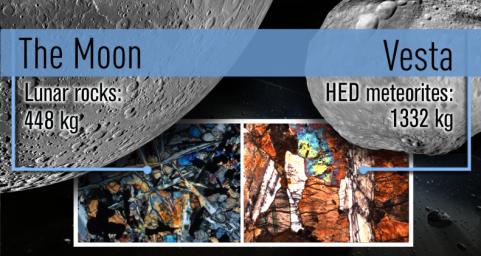
|
A Shared Bombardment History
- Click the image above for a larger view
- Full-Res JPEG (1824 x 970) (301.9 kB)
- Full-Res TIFF (1824 x 970) (5.3 MB)
Caption:
Scientists have now discovered that studying meteorites from the giant asteroid Vesta helps them understand the event known as the "lunar cataclysm," when a repositioning of the gas giant planets destabilized a portion of the asteroid belt and triggered a solar-system-wide bombardment. Previously, scientists had only lunar samples to work with. Scientists are now using a class of meteorites connected to Vesta -- known as howardite, eucrite and diogenite meteorites -- to study the lunar cataclysm, providing about three times more samples to analyze.
The left-hand mosaic of the far side of the moon is based on data from NASA's Lunar Reconnaissance Orbiter. On the right is an image of Vesta from data obtained by NASA's Dawn spacecraft. The insets show thin sections of the lunar sample 10069-13 and eucrite NWA1978.
Background Info:
More information about Dawn is online at http://www.nasa.gov/dawn and http://dawn.jpl.nasa.gov .
Cataloging Keywords:
| Name | Value | Additional Values |
|---|---|---|
| Target | 4 Vesta | |
| System | Main Belt | |
| Target Type | Asteroid | |
| Mission | Dawn | Lunar Reconnaissance Orbiter (LRO) |
| Instrument Host | Dawn | Lunar Reconnaissance Orbiter |
| Host Type | Orbiter | |
| Instrument | ||
| Detector | ||
| Extra Keywords | Color, Moon | |
| Acquisition Date | ||
| Release Date | 2013-03-25 | |
| Date in Caption | ||
| Image Credit | NASA/GSFC/ASU/JPL-Caltech/UCLA/MPS/DLR/IDA | |
| Source | photojournal.jpl.nasa.gov/catalog/PIA16841 | |
| Identifier | PIA16841 | |
